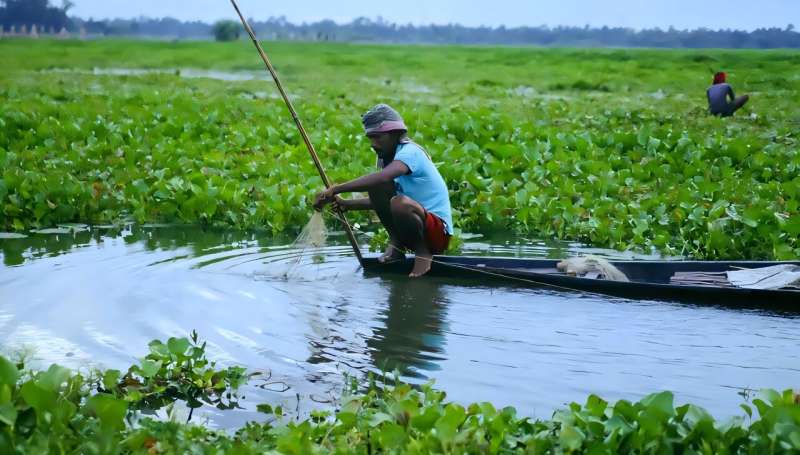
Fentie Wabi had been fishing on Lake Tana in Ethiopia for many years until an invasive green plant altered everything.
This troublesome water hyacinth, a weed that spreads rapidly, started to overcrowd the lake, disrupting life for the local community.
“As the weeds spread, navigating our boats became impossible. They damaged our nets, and we lost access to our usual fishing spots,” Wabi explained.
Pushed to restore their waters, fishermen in the village of Shehagomngie attempted to manually remove the hyacinth, but the effort proved exhausting and ineffective.
“Even after we cleared it out, it always came back quickly,” Wabi recounted. “The waste kept piling up, overtaking the surrounding land.”
When researchers launched a new project, Wabi was eager to participate.
This innovative initiative transformed the invasive weeds into household energy sources like cooking fuel while also cleaning the lake.
Wabi shared, “After setting up the biogas system, our situation improved significantly.” Now his family uses the gas for cooking and lighting, reducing their dependence on firewood.
Moreover, he now applies the leftover material from the process as fertilizer for his small farm, leading to better harvests compared to earlier seasons when he used chemical fertilizers.
“Since I started using the slurry, my crops are thriving and appear healthier,” he said. “I’m also saving money by not having to purchase expensive fertilizers.”
Rapid Invasion
Yezbie Kassa, the lead researcher of this project and assistant professor at the University of Gondar, observed Lake Tana’s ecosystem during her Ph.D. studies.
She noted alarming changes as the water hyacinth spread uncontrollably across the lake.
“This invasive species not only harms the lake’s ecosystem but also endangers the livelihoods of communities that rely on it for food, income, and clean water,” she stated.
Despite numerous cleanup efforts by the community and local government, the infestation persisted.
“The plant was expanding rapidly and pushing out native species,” Kassa remembered. “Even in areas where it was removed, tons of waste lingered in villages, causing further environmental and health issues.”
Realizing that eradicating the weed wasn’t enough, Kassa recognized the need to find a valuable use for it.
“I felt a pressing need to transform this invasive plant into something beneficial,” she said. “That’s how the biogas idea was born—out of necessity and opportunity.”
Green Energy
Kassa discovered that decaying water hyacinth released an oily substance, which sparked her idea to harness it as an energy source.
She recognized the potential for using the waste to produce biogas while the remaining byproduct could serve as fertilizer, providing a dual advantage.
The process is pretty simple, according to Kassa. The waste from the water hyacinth, along with animal dung, is fed into biogas digesters.
Over several weeks, this organic matter breaks down, generating biogas through a method called anaerobic digestion. The result is primarily methane and carbon dioxide.
The leftover material, known as bioslurry, turns into natural fertilizer.
Kassa pointed out that water hyacinth generates a greater volume of biogas than many other substances due to its rich content. It also produces a higher concentration of methane while releasing fewer harmful emissions, making it a healthier option.
Though initially implemented in just five households, this project has laid the groundwork for further community learning.
At first, many villagers were doubtful, but “once they saw lights turn on and smelled the cooking gas, their skepticism faded and enthusiasm grew,” Kassa shared.
Women, in particular, benefit from this innovation, as it saves them from the long hours spent gathering firewood and cooking over smoky stoves.
Government Support
Getachew Sime Feyissa, an associate professor of agroecology at Hawassa University, noted that converting invasive plants into biogas, biofertilizer, crafts, or feed is gaining traction.
“These strategies provide environmental benefits while also creating job opportunities,” he explained.
“However, for these solutions to transition from pilot projects to widespread initiatives, they require stronger support from the government, dedicated funding, and specific policy measures.”
Challenges in Ethiopia’s rural conflict zones and rising costs complicate the expansion of this biogas initiative.
“The biogas tanks are made from imported materials, which can be costly,” Kassa remarked, emphasizing the need for government subsidies to make them accessible to more families.
She also suggested forming cooperatives to share financial and material responsibilities among households.
As this invasive plant spreads across Ethiopia’s Rift Valley and other lakes, Kassa believes the model is ready to expand.
“Stakeholders from all levels of government have expressed keen interest,” she said. “They are closely monitoring the project, and I anticipate it will lead to broader implementation in other regions.”
“With solid policy support, adequate funding, and coordinated efforts, this innovation could benefit communities all over the country.”
If you would like to see similar Tech posts like this, click here & share this article with your friends!

